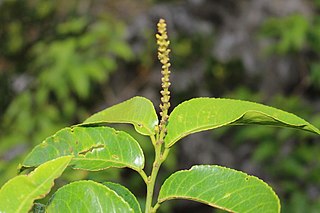
Aloe is a genus containing over 650 species of flowering succulent plants. The most widely known species is Aloe vera, or "true aloe". It is called this because it is cultivated as the standard source for assorted pharmaceutical purposes. Other species, such as Aloe ferox, are also cultivated or harvested from the wild for similar applications.

Colchicaceae is a family of flowering plants that includes 15 genera with a total of about 285 known species according to Christenhusz and Byng in 2016.

Shirakiopsis is a genus of flowering plants in the family Euphorbiaceae first described as a genus in 1999. There are six known species, 3 native to tropical Asia and 3 to tropical Africa.

Watsonia is a genus of plants in the family Iridaceae, subfamily Crocoideae. Watsonias are native to southern Africa. The genus is named after Sir William Watson, an 18th-century British botanist.

The Cabombaceae are a family of aquatic, herbaceous flowering plants. A common name for its species is water shield. The family is recognised as distinct in the Angiosperm Phylogeny Group IV system (2016). The family consists of two genera of aquatic plants, Brasenia and Cabomba, totalling six species.

Lanaria is a monotypic genus of flowering plants containing a single species, Lanaria lanata, endemic to the southern coast of South Africa where it is associated with the fynbos belt. Lanaria lanata is commonly known as Cape edelweiss or lambtails. The genus is placed in the monotypic family Lanariaceae, a family only recently recognized by taxonomists. The APG IV system of 2016 does recognize this family.

Freesia laxa, commonly known as flowering grass, is a small species of cormous flowering plant in the family Iridaceae, from eastern and southern Africa, from Kenya to northeastern South Africa. It is grown in gardens as an ornamental plant.

Tritonia is a genus of flowering plants in the iris family first described as a genus in 1802. They are naturally distributed across southern Africa, with a high concentration of species in Cape Province of western South Africa. The genus is closely related to the genus Ixia.

Zephyranthes robusta, commonly known as the Brazilian copperlily, pink fairy lily or the pink rain lily, is a species of herbaceous flowering bulb in the family Amaryllidaceae. It is native to Brazil, Argentina and Uruguay, but is now naturalized in Florida, Colombia, South Africa, and Mauritius.

Sternbergia is a genus of Eurasian and North African plants in the Amaryllis family, subfamily Amaryllidoideae.

Aristea is a genus of evergreen, perennial and rhizomatous species of flowering plants in the family Iridaceae, first described in 1789. The genus is distributed in tropical and southern Africa, as well as Madagascar. The genus name is derived from the Greek word arista, meaning "awn".

Radinosiphon is a genus of flowering plants in the family Iridaceae first described as a genus in 1932. It is native to southern + southeastern Africa.

Syringodea is a genus of flowering plants in the family Iridaceae, first described as a genus in 1873. The entire genus is endemic to South Africa.

Drimia is a genus of African, south European and south Asian flowering plants. In the APG IV classification system, it is placed in the family Asparagaceae, subfamily Scilloideae. When broadly circumscribed, the genus includes a number of other genera previously treated separately, including Litanthus, Rhodocodon, Schizobasis and Urginea.
Drimia indica is a species of flowering plant found from South Asia to South Africa.

Dipcadi is a genus of bulbous flowering plants in the family Asparagaceae, subfamily Scilloideae. It is widely distributed, occurring in southern Europe, most of Africa and the Middle East through to the Indian subcontinent.

Iphigenia is a flowering plant in the family Colchicaceae. It was described by Kunth. It consists of 11 species distributed from tropical Africa, over Madagascar and India to Australia. As with other taxa in Colchicaceae Iphigenia contains phenethylisoquinoline alkaloids including colchicine.

Albuca humilis is a bulbous flowering plant, placed in the genus Albuca in the subfamily Scilloideae of the family Asparagaceae. It is native to southern Africa – to South Africa from the Free State to KwaZulu-Natal according to some sources, or to the Drakensberg Mountains of Lesotho according to others.

Vicoa is a genus of flowering plants belonging to elecampane tribe within the Asteraceae. It is found in parts of Africa and stretching across Asia to Indochina. It was described by Alexandre Henri Gabriel de Cassini (Cass.) in 1829, but the genus was later absorbed into the Pentanema genus. Until molecular analysis in 2018, determined it was a separate genus.

Kewa is a genus of flowering plants, consisting of eight species of succulent sub-woody plants, native to eastern and southern Africa, including Saint Helena and Madagascar. These are small shrubs or herbs that form cushions and have edible, acid-tasting leaves. Kewa is the only genus in the family Kewaceae.



















